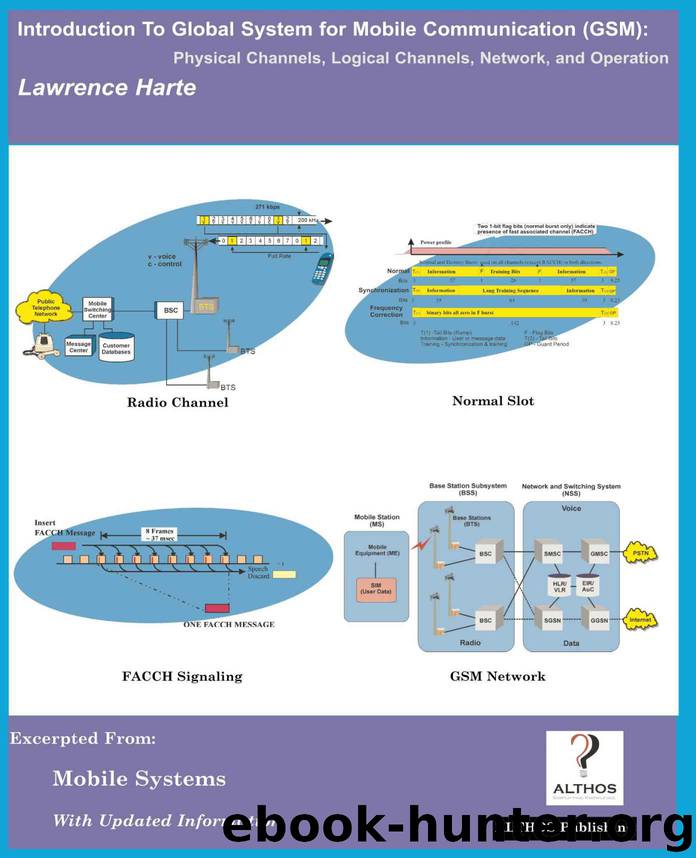Introduction to GSM: Physical Channels, Logical Channels, Network, and Operation by Lawrence Harte

Author:Lawrence Harte [Harte, Lawrence]
Language: eng
Format: azw3
Publisher: UNKNOWN
Published: 2017-03-22T04:00:00+00:00
Figure 1.22., Logical Channels Used in GSM Systems
Dedicated Control Channel Signaling Dedicated control channels are a signaling channel that is used solely for control of a specific device. The GSM system uses dedicated control channels to assist with radio channel assignment and to control the mobile telephone while it is on a traffic channel (voice call or data session).
Stand Alone Dedicated Control Channel (SDCCH) The stand alone dedicated control channel is a signaling channel that can be used to coordinate the radio channel assignment of a mobile device after it has successfully competed for access. The SDCCH channel is used for off air call setup (OACSU) to allow the mobile device to authenticate and complete other control processes without being assigned to a dedicated traffic channel.
Traffic Channel Signaling Signaling on the traffic channel is divided into two channels; the Fast Associated Control Channel (FACCH) and the Slow Associated Control Channel (SACCH). The FACCH replaces speech with signal data. The SACCH uses dedicated (scheduled) frames within each burst.
Slow Associated Control Channel (SACCH) Slow associated control channel (SACCH) is used to continuously transmit certain call processing and control signals at a low bit rate. The SACCH is normally sent along with user data so it does not subtract or use bits from the user data portion. It is therefore sometimes called “out of band” transmission. In full-rate GSM systems, the SACCH data is transmitted in the same time slot that would otherwise be used for digital subscriber traffic. During a scheduled sequence of 26 transmission frames, 24 of these carry digital subscriber traffic, one carries SACCH data, and one is not used.
SACCH is primarily used to transfer radio channel signal quality information from the mobile device to the base station to assist with the handover process. Because SACCH messages do not replace user data (voice signals), the sending of SACCH messages does not affect the quality of speech. However, the data transmission rate of the SACCH is very low and the transmission delay is approximately ½ second.
Figure 1.23 illustrates the SACCH signaling process. This example shows that SACCH messages do not replace voice data, it is sent on a dedicated SACCH time slot on 26 traffic multiframes. Because the SACCH message is distributed over multiple time slots, each SACCH message experiences a delay of approximately 480 msec.
Download
This site does not store any files on its server. We only index and link to content provided by other sites. Please contact the content providers to delete copyright contents if any and email us, we'll remove relevant links or contents immediately.
| Automotive | Engineering |
| Transportation |
Whiskies Galore by Ian Buxton(41880)
Introduction to Aircraft Design (Cambridge Aerospace Series) by John P. Fielding(33064)
Small Unmanned Fixed-wing Aircraft Design by Andrew J. Keane Andras Sobester James P. Scanlan & András Sóbester & James P. Scanlan(32743)
Craft Beer for the Homebrewer by Michael Agnew(18141)
Turbulence by E. J. Noyes(7936)
The Complete Stick Figure Physics Tutorials by Allen Sarah(7307)
Kaplan MCAT General Chemistry Review by Kaplan(6867)
The Thirst by Nesbo Jo(6828)
Bad Blood by John Carreyrou(6552)
Modelling of Convective Heat and Mass Transfer in Rotating Flows by Igor V. Shevchuk(6391)
Learning SQL by Alan Beaulieu(6211)
Weapons of Math Destruction by Cathy O'Neil(6146)
Man-made Catastrophes and Risk Information Concealment by Dmitry Chernov & Didier Sornette(5921)
Digital Minimalism by Cal Newport;(5664)
Life 3.0: Being Human in the Age of Artificial Intelligence by Tegmark Max(5474)
iGen by Jean M. Twenge(5366)
Secrets of Antigravity Propulsion: Tesla, UFOs, and Classified Aerospace Technology by Ph.D. Paul A. Laviolette(5309)
Design of Trajectory Optimization Approach for Space Maneuver Vehicle Skip Entry Problems by Runqi Chai & Al Savvaris & Antonios Tsourdos & Senchun Chai(5011)
Pale Blue Dot by Carl Sagan(4912)
